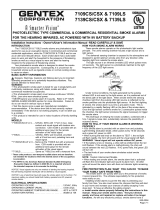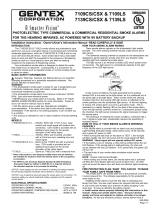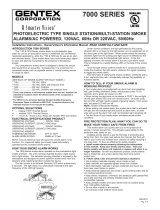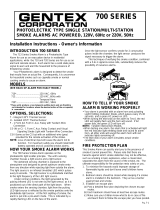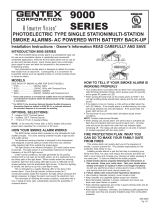
WHAT THIS SMOKE ALARM CAN DO
This smoke alarm is designed to sense smoke entering its sensing chamber. It
does not sense gas, heat, or flames.
When properly located, installed, and maintained, this smoke alarm is designed to
provide early warning of developing fires at a reasonable cost. This smoke alarm
monitors the air and, when it senses smoke, activates its built-in alarm horn and
strobe light. It can provide precious time for you and your family to escape from your
residence before a fire spreads. Such an early warning, however, is possible only if
the smoke alarm is located, installed, and maintained as specified in this User's
Manual.
NOTICE: THIS SMOKE ALARM IS DESIGNED FOR USE WITHIN SINGLE
RESIDENTIAL LIVING UNITS ONLY; THAT IS, IT SHOULD BE USED INSIDE A
SINGLE-FAMILY HOME OR ONE APARTMENT OF A MULTI-FAMILY BUILDING. IN
A MULTI-FAMILY BUILDING, THE SMOKE ALARM MAY NOT PROVIDE EARLY
WARNING FOR RESIDENTS IF IT IS PLACED OUTSIDE OF THE RESIDENTIAL
UNITS, SUCH AS ON OUTSIDE PORCHES, IN CORRIDORS, LOBBIES,
BASEMENTS, OR IN OTHER APARTMENTS. IN MULTI-FAMILY BUILDINGS,
EACH RESIDENTIAL UNIT SHOULD HAVE SMOKE ALARMS TO ALERT THE
RESIDENTS OF THAT UNIT. SMOKE ALARMS DESIGNED TO BE
INTERCONNECTED SHOULD BE INTERCONNECTED WITHIN ONE FAMILY
RESIDENCE ONLY; OTHERWISE, NUISANCE ALARMS WILL OCCUR WHEN A
SMOKE ALARM IN ANOTHER LIVING UNIT IS TESTED.
NOTICE: WHAT SMOKE ALARMS CANNOT DO
Smoke alarms will not work without power. A battery must be connected to the
smoke alarm to maintain proper device operation if AC power supply is cut off by an
electrical fire, open fuse or circuit breaker, or for any other reason. In the event of AC
power failure, the battery will supply standby power for a minimum of 24 hours.
Visual signal will not operate on battery power alone. Smoke
alarms may not sense fire that starts where smoke cannot reach the devices
such as in chimneys, in walls, on roofs, or on the other side of closed doors. If
bedroom doors are usually closed at night, smoke alarms should be placed in each
bedroom as well as in the common hallway between them.
Smoke alarms also may not sense a fire on another level of a residence or
building. For example, a second-floor smoke alarm may not sense a first-floor or
basement fire. Therefore, smoke alarms should be placed on every level of a
residence or building.
The horn and visual signal in your smoke alarm meets or exceeds current
audibility and visual requirements of ANSI/UL 217. However, if the smoke alarm is
located outside a bedroom, the visual signal will not be seen or noticed by
occupant and piezo sounder will not wake up a sound sleeper, especially if the
bedroom door is closed or only partly open. If the smoke alarm is located on a
different level of the residence than the bedroom, it is even less likely to awaken
people sleeping in the bedroom. In such cases, the National Fire Protection
Association recommends that the smoke alarms be interconnected so that a device
on any level of the residence will sound an alarm loud enough to awaken sleepers in
closed bedrooms. This can be done by employing a systematic approach by
interconnecting smoke alarms together, or by using radio frequency transmitters and
receivers.
All types of smoke alarm sensors have limitations. No type of device can
sense every kind of fire every time. These types of fires include:
1) Fires where the victim is intimate with a flaming initiated fire; for example,
when a person’s clothes catch on fire while cooking.
2) Fires where the smoke is prevented from reaching the smoke alarm due to a
closed door or other obstruction.
3) Incendiary fires where the fire grows so rapidly that an occupant’s egress is
blocked even with properly located smoke alarms.
In general, smoke alarms may not always warn you about fires caused by
violent explosions, escaping gas, improper storage of flammable materials, or
arson.
NOTICE: THIS SMOKE ALARM IS NOT DESIGNED TO REPLACE SPECIAL-
PURPOSE FIRE DETECTION AND SMOKE ALARM SYSTEMS NECESSARY TO
PROTECT PERSONS AND PROPERTY IN NON-RESIDENTIAL BUILDINGS SUCH
AS WAREHOUSES, OR OTHER LARGE INDUSTRIAL OR COMMERCIAL
BUILDINGS. IT ALONE IS NOT A SUITABLE SUBSTITUTE FOR COMPLETE
FIRE-DETECTION SYSTEMS DESIGNED TO PROTECT INDIVIDUALS IN HOTELS
AND MOTELS, DORMITORIES, HOSPITALS, OR OTHER HEALTH AND
SUPERVISORY CARE AND RETIREMENT HOMES. PLEASE REFER TO NFPA
101,THE LIFE SAFETY CODE, AND NFPA 72 FOR SMOKE ALARM
REQUIREMENTS FOR FIRE PROTECTION IN BUILDINGS NOT DEFINED AS
"HOUSEHOLDS."
Installing smoke alarms may make you eligible for lower insurance rates, but
smoke alarms are not a substitute for insurance. Home owners and renters
should continue to insure their lives and property.
Visual signals are only one method of alerting the hearing impaired to a fire. The
visual signal may not awaken all hearing impaired individuals. The visual signal must
be in the line of sight of the individual to be seen and effective.
550-0094
Page 7-2
Keep electrical appliances and cords in good working order and do not overload
electrical circuits.
Keep stoves, fireplaces, chimneys, and barbecue grills grease-free and make sure
they are properly installed away from combustible materials.
Keep portable heaters and open flames such as candles away from combustible
materials.
Do not allow rubbish to accumulate.
Do not leave small children home alone.
c. Develop a family escape plan and practice it with your entire family,
especially small children.
Draw and post a floor plan of your home and find two ways to exit from each room.
There should be one way to get out of each bedroom without opening the door.
Teach children what the smoke alarm signal means, and that they must be
prepared to leave the residence by themselves if necessary. Show them how to
check to see if doors are hot before opening them, how to stay close to the floor
and crawl if necessary, and how to use the alternate exit if door is hot and should
not be opened.
Decide on a meeting place a safe distance from your house and make sure that all
your children understand that they should go and wait for you if there is a fire.
Hold fire drills at least every 6 months to make sure that everyone, even small
children, know what to do to escape safely.
Know where to go to call the fire department from outside your residence.
Provide emergency equipment such as fire extinguishers and teach your family to
use this equipment properly.
d. Bedroom doors should be closed while sleeping if a smoke alarm is installed
in the bedroom. They act as a barrier against heat and smoke.
WHAT TO DO IF THERE IS A FIRE IN YOUR HOME
If you have prepared family escape plans and practiced them with your family, you
have increased their chances of escaping safely. Review the following rules with your
children when you have fire drills so everyone will remember them in a real fire
emergency. If the alarm should sound:
a. Don't panic; stay calm. Your safe escape may depend on thinking clearly and
remembering what you have practiced.
b. Get out of the house following a planned escape route as quickly as possible. Do
not stop to collect anything or to get dressed.
c. Open doors carefully only after feeling to see if they are hot. Do not open a door
if it is hot; use an alternate escape route.
d. Stay close to the floor; smoke and hot gases rise.
e. Cover your nose and mouth with a cloth, wet if possible, and take short, shallow
breaths.
f. Keep doors and windows closed unless you open them to escape.
g. Meet at your prearranged meeting place after leaving the house.
h. Call the Fire Department as soon as possible from outside your house. Give the
address and your name.
i. Never re-enter a burning building.
Contact your local Fire Department for more information on making your home
safer from fires and preparing your family's escape plans.
NOTICE: CURRENT STUDIES HAVE SHOWN SMOKE ALARMS MAY NOT
AWAKEN ALL SLEEPING INDIVIDUALS, AND THAT IT IS THE RESPONSIBILITY
OF INDIVIDUALS IN THE HOUSEHOLD THAT ARE CAPABLE OF ASSISTING
OTHERS TO PROVIDE ASSISTANCE TO THOSE WHO MAY NOT BE AWAKENED
BY THE ALARM SOUND, OR TO THOSE WHO MAY BE INCAPABLE OF SAFELY
EVACUATING THE AREA UNASSISTED.
NOTICE: VISUAL SIGNALS ARE ONLY ONE METHOD OF ALERTING THE
HEARING IMPAIRED TO A FIRE. THE VISUAL SIGNAL MAY NOT AWAKEN ALL
HEARING IMPAIRED INDIVIDUALS. THE VISUAL SIGNAL MUST BE IN THE LINE
OF SIGHT OF THE INDIVIDUAL TO BE SEEN AND EFFECTIVE.
Visual signal should NEVER
be relied upon as the primary
fire alert for the hearing impaired under these common sense conditions:
a. Sleeping face down on the bedding or pillow
b. Use of sleep medications of any kind
c. Use of alcoholic beverages or recreational drugs
d. Use of eye shades
e. If there are tendencies of deep sleep conditions
f. If a fire cuts power to AC circuits, the visual signal will not operate
g. If person is not within line of sight of visual signal
Under these and other similar common situations an alternate fire alert
method such as a non-hearing impaired attendant is needed. The visual signal
only increases the chance of being alerted to the presence of fire. No system
of this type can fully protect the hearing impaired in case of fire.






